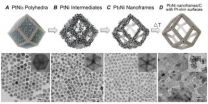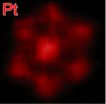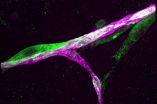(Press-News.org) A big step in the development of next-generation fuel cells and water-alkali electrolyzers has been achieved with the discovery of a new class of bimetallic nanocatalysts that are an order of magnitude higher in activity than the target set by the U.S. Department of Energy (DOE) for 2017. The new catalysts, hollow polyhedral nanoframes of platinum and nickel, feature a three-dimensional catalytic surface activity that makes them significantly more efficient and far less expensive than the best platinum catalysts used in today's fuel cells and alkaline electrolyzers. This research was a collaborative effort between DOE's Lawrence Berkeley National Laboratory (Berkeley Lab) and Argonne National Laboratory (ANL).
"We report the synthesis of a highly active and durable class of electrocatalysts by exploiting the structural evolution of platinum/nickel bimetallic nanocrystals," says Peidong Yang, a chemist with Berkeley Lab's Materials Sciences Division, who led the discovery of these new catalysts. "Our catalysts feature a unique hollow nanoframe structure with three-dimensional platinum-rich surfaces accessible for catalytic reactions. By greatly reducing the amount of platinum needed for oxygen reduction and hydrogen evolution reactions, our new class of nanocatalysts should lead to the design of next-generation catalysts with greatly reduced cost but significantly enhanced activities."
Yang, who also holds appointments with the University of California (UC) Berkeley and the Kavli Energy NanoSciences Institute at Berkeley, is one of the corresponding authors of a paper in Science that describes this research. The paper is titled "Highly Crystalline Multimetallic Nanoframes with Three-Dimensional Electrocatalytic Surfaces." The other corresponding author is Vojislav Stamenkovic, a chemist with ANL's Materials Science Division, who led the testing of this new class of electrocatalysts.
Fuel cells and electrolyzers can help meet the ever-increasing demands for electrical power while substantially reducing the emission of carbon and other atmospheric pollutants. These technologies are based on either the oxygen reduction reaction (fuel cells), or the hydrogen evolution reaction (electrolyzers). Currently, the best electrocatalyst for both reactions consists of platinum nanoparticles dispersed on carbon. Though quite effective, the high cost and limited availability of platinum makes large-scale use of this approach a major challenge for both stationary and portable electrochemical applications.
"Intense research efforts have been focused on developing high-performance electrocatalysts with minimal precious metal content and cost," Yang says. "In an earlier study, the ANL scientists showed that forming a nano-segregated platinum skin over a bulk single-crystal platinum/nickel alloy enhances catalytic activity but the materials cannot be easily integrated into electrochemical devices. We needed to be able to reproduce the outstanding catalytic performance of these materials in nanoparticulates that offered high surface areas."
Yang and his colleagues at Berkeley accomplished this by transforming solid polyhedral bimetallic nanoparticles of platinum and nickel into hollow nanoframes. The solid polyhedral nanoparticles are synthesized in the reagent oleylamine, then soaked in a solvent, such as hexane or chloroform, for either two weeks at room temperature, or for 12 hours at 120 degrees Celsius. The solvent, with its dissolved oxygen, causes a natural interior erosion to take place that results in a hollow dodecahedron nanoframe. Annealing these dodecahedron nanoframes in argon gas creates a platinum skin on the nanoframe surfaces.
"In contrast to other synthesis procedures for hollow nanostructures that involve corrosion induced by harsh oxidizing agents or applied potential, our method proceeds spontaneously in air," Yang says. "The open structure of our platinum/nickel nanoframes addresses some of the major design criteria for advanced nanoscale electrocatalysts, including, high surface-to-volume ratio, 3-D surface molecular accessibility, and significantly reduced precious metal utilization."
In electrocatalytic performance tests at ANL, the platinum/nickel nanoframes when encapsulated in an ionic liquid exhibited a 36-fold enhancement in mass activity and 22-fold enhancement in specific activity compared with platinum nanoparticles dispersed on carbon for the oxygen reduction reaction. These nanoframe electrocatalysts, modified by electrochemically deposited nickel hydroxide, were also tested for the hydrogen evolution reaction and showed that catalytic activity was enhanced by an order-of-magnitude over platinum/carbon catalysts.
"Our results demonstrate the beneficial effects of the hollow nanoframe's open architecture and surface compositional profile," Yang says. "Our technique for making these hollow nanoframes can be readily applied to other multimetallic electrocatalysts or gas phase catalysts. I am quite optimistic about its commercial viability."
INFORMATION:
Other co-authors of the Science paper in addition to Yang and Stamenkovic are Chen Chen, Yijin Kang, Ziyang Huo, Zhongwei Zhu, Wenyu Huang, Huolin Xin, Joshua Snyder, Dongguo Li, Jeffrey Herron, Manos Mavrikakis, Miaofang Chi, Karren More, Yadong Li, Nenad Markovic and Gabor Somorjai.
This research was funded by the DOE Office of Science.
Lawrence Berkeley National Laboratory addresses the world's most urgent scientific challenges by advancing sustainable energy, protecting human health, creating new materials, and revealing the origin and fate of the universe. Founded in 1931, Berkeley Lab's scientific expertise has been recognized with 13 Nobel prizes. The University of California manages Berkeley Lab for the U.S. Department of Energy's Office of Science. For more, visit http://www.lbl.gov.
Argonne National Laboratory seeks solutions to pressing national problems in science and technology. The nation's first national laboratory, Argonne conducts leading-edge basic and applied scientific research in virtually every scientific discipline. Argonne researchers work closely with researchers from hundreds of companies, universities, and federal, state and municipal agencies to help them solve their specific problems, advance America's scientific leadership and prepare the nation for a better future. With employees from more than 60 nations, Argonne is managed by UChicago Argonne, LLC for the U.S. Department of Energy's Office of Science. For more visit http://www.anl.gov
DOE's Office of Science is the single largest supporter of basic research in the physical sciences in the United States, and is working to address some of the most pressing challenges of our time. For more information, please visit the Office of Science website at science.energy.gov/.
Big step for next-generation fuel cells and electrolyzers
Researchers at Berkeley and Argonne National Labs develop highly promising new class of nanocatalyst
2014-02-27
ELSE PRESS RELEASES FROM THIS DATE:
Fossilized human feces from 14th century contain antibiotic resistance genes
2014-02-27
A team of French investigators has discovered viruses containing genes for antibiotic resistance in a fossilized fecal sample from 14th century Belgium, long before antibiotics were used in medicine. They publish their findings ahead of print in the journal Applied and Environmental Microbiology.
"This is the first paper to analyze an ancient DNA viral metagenome," says Rebecca Vega Thurber of Oregon State University, Corvallis, who was not involved in the research.
The viruses in the fecal sample are phages, which are viruses that infect bacteria, rather than infecting ...
Physicians' stethoscopes more contaminated than palms of their hands
2014-02-27
VIDEO:
A comparative analysis shows that stethoscope diaphragms are more contaminated than the physician's own thenar eminence (group of muscles in the palm of the hand) following a physical examination.
Click here for more information.
Rochester, MN, February 27, 2014 – Although healthcare workers' hands are the main source of bacterial transmission in hospitals, physicians' stethoscopes appear to play a role. To explore this question, investigators at the University of ...
Study reveals mechanisms cancer cells use to establish metastatic brain tumors
2014-02-27
NEW YORK, NY, February 27, 2014 — New research from Memorial Sloan Kettering provides fresh insight into the biologic mechanisms that individual cancer cells use to metastasize to the brain. Published in the February 27 issue of Cell, the study found that tumor cells that reach the brain — and successfully grow into new tumors — hug capillaries and express specific proteins that overcome the brain's natural defense against metastatic invasion.
Metastasis, the process that allows some cancer cells to break off from their tumor of origin and take root in a different tissue, ...
Methane leaks from palm oil wastewater are a climate concern, CU-Boulder study says
2014-02-27
In recent years, palm oil production has come under fire from environmentalists concerned about the deforestation of land in the tropics to make way for new palm plantations. Now there is a new reason to be concerned about palm oil's environmental impact, according to researchers at the University of Colorado Boulder.
An analysis published Feb. 26 in the journal Nature Climate Change shows that the wastewater produced during the processing of palm oil is a significant source of heat-trapping methane in the atmosphere. But the researchers also present a possible solution: ...
Famed Milwaukee County Zoo orangutan's death caused by strange infection
2014-02-27
MADISON – Mahal, the young orangutan who became a star of the Milwaukee County Zoo and an emblem of survival for a dwindling species, led an extraordinary life.
It turns out, the young ape died an extraordinary death, too.
Rejected by his biological mother at the Cheyenne Mountain Zoo in Colorado Springs, Colo., and eventually flown to Milwaukee aboard a private jet to live with a surrogate mother, Mahal became one of the Milwaukee County Zoo's star attractions. His unexpected death at age 5 in late December 2012 was a shock to the community that came to know him through ...
Scientists describe deadly immune 'storm' caused by emergent flu infections
2014-02-27
LA JOLLA, CA—February 26, 2014—Scientists at The Scripps Research Institute (TSRI) have mapped key elements of a severe immune overreaction—a "cytokine storm"—that can both sicken and kill patients who are infected with certain strains of flu virus.
Their findings, published in this week's online Early Edition of the Proceedings of the National Academy of Sciences, also clarify the workings of a potent new class of anti-inflammatory compounds that prevent this immune overreaction in animal models.
"We show that with this type of drug, we can quiet the storm enough to ...
Livestock found ganging up on pandas at the bamboo buffet
2014-02-27
VIDEO:
A panda in the Wolong Nature Reserve munches on bamboo -- which comprises 99 percent of the endangered species' diet in the wild.
Click here for more information.
Pandas, it turns out, aren't celebrating the Year of the Horse.
Livestock, particularly horses, have been identified as a significant threat to panda survival. The reason: They're beating the pandas to the bamboo buffet. A paper by Michigan State University panda habitat experts published in this week's Journal ...
Making treatment of rare blood disorder more affordable and effective
2014-02-27
PHILADELPHIA — A University of Pennsylvania research team has defined a possible new way to fight a disease that is currently treatable only with the most expensive drug available for sale in the United States. In a study published this month in Blood, the Penn team describes the strategy, based on the oldest part of the human immune system – called "complement" -- that could turn out to be less costly and more effective for the majority of patients with a rare blood disorder.
Complement is a network of more than 50 proteins in the blood and on cell surfaces that quietly ...
International study shows majority of children unaware of cigarette warning labels
2014-02-27
College Park, Md. -- An international study of children's perceptions of cigarette package warning labels found that the majority of children are unaware that they exist. Children in countries where larger warning labels are used, and which include a compelling graphic image of the negative health impacts of smoking, were more likely to be aware of and understand the health risks of tobacco products.
The study, led by Dina Borzekowski, Ed.D, in the University of Maryland School of Public Health (UMD SPH), and Joanna Cohen, PhD, Johns Hopkins Bloomberg School of Public ...
AGU: A 'shark's eye' view: Witnessing the life of a top predator
2014-02-27
HONOLULU – Instruments strapped onto and ingested by sharks are revealing novel insights into how one of the most feared and least understood ocean predators swims, eats and lives.
For the first time, researchers at the University of Hawaii and the University of Tokyo outfitted sharks with sophisticated sensors and video recorders to measure and see where they are going, how they are getting there, and what they are doing once they reach their destinations. (Go to http://www.youtube.com/watch?v=UHDOAmXRw-0&feature=youtu.be for video).
Scientists are also piloting ...
LAST 30 PRESS RELEASES:
Making lighter work of calculating fluid and heat flow
Normalizing blood sugar can halve heart attack risk
Lowering blood sugar cuts heart attack risk in people with prediabetes
Study links genetic variants to risk of blinding eye disease in premature infants
Non-opioid ‘pain sponge’ therapy halts cartilage degeneration and relieves chronic pain
AI can pick up cultural values by mimicking how kids learn
China’s ecological redlines offer fast track to 30 x 30 global conservation goal
Invisible indoor threats: emerging household contaminants and their growing risks to human health
Adding antibody treatment to chemo boosts outcomes for children with rare cancer
Germline pathogenic variants among women without a history of breast cancer
Tanning beds triple melanoma risk, potentially causing broad DNA damage
Unique bond identified as key to viral infection speed
Indoor tanning makes youthful skin much older on a genetic level
Mouse model sheds new light on the causes and potential solutions to human GI problems linked to muscular dystrophy
The Journal of Nuclear Medicine ahead-of-print tip sheet: December 12, 2025
Smarter tools for peering into the microscopic world
Applications open for funding to conduct research in the Kinsey Institute archives
Global measure underestimates the severity of food insecurity
Child survivors of critical illness are missing out on timely follow up care
Risk-based vs annual breast cancer screening / the WISDOM randomized clinical trial
University of Toronto launches Electric Vehicle Innovation Ontario to accelerate advanced EV technologies and build Canada’s innovation advantage
Early relapse predicts poor outcomes in aggressive blood cancer
American College of Lifestyle Medicine applauds two CMS models aligned with lifestyle medicine practice and reimbursement
Clinical trial finds cannabis use not a barrier to quitting nicotine vaping
Supplemental nutrition assistance program policies and food insecurity
Switching immune cells to “night mode” could limit damage after a heart attack, study suggests
URI-based Global RIghts Project report spotlights continued troubling trends in worldwide inhumane treatment
Neutrophils are less aggressive at night, explaining why nighttime heart attacks cause less damage than daytime events
Menopausal hormone therapy may not pose breast cancer risk for women with BRCA mutations
Mobile health tool may improve quality of life for adolescent and young adult breast cancer survivors
[Press-News.org] Big step for next-generation fuel cells and electrolyzersResearchers at Berkeley and Argonne National Labs develop highly promising new class of nanocatalyst






